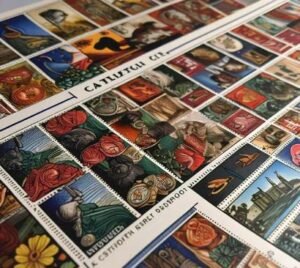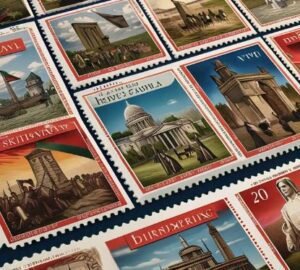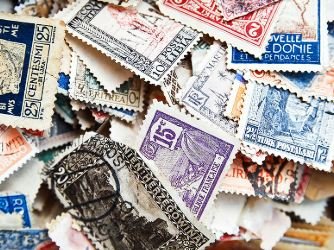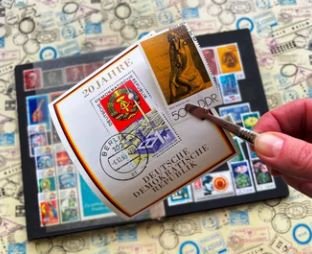For stamp collectors, cataloging is a vital aspect of managing a collection. Whether you are a novice just starting out or an experienced philatelist, best practices for cataloging stamps can help you keep track of your collection, avoid costly errors, and preserve the value of your stamps over time. Properly cataloging your stamps isn’t just about organization—it’s about making your collection more accessible, manageable, and valuable. In this article, we’ll explore the best practices for cataloging stamps to help you refine your collection, prevent mistakes, and increase your knowledge of philately.

Why Cataloging Your Stamps Is Essential
Before diving into the specifics of best practices for cataloging stamps, it’s important to understand why cataloging is so essential for any collector. A well-organized stamp collection can provide several benefits, including:
- Preservation of Value: Proper cataloging helps maintain the authenticity and value of your stamps. It enables you to track any changes in value and identify rare or special editions.
- Efficient Organization: Cataloging allows you to find specific stamps easily, saving you time when you need to show or assess your collection.
- Protection from Loss or Theft: Keeping a detailed record of your collection helps protect it in the event of loss, damage, or theft. An inventory is indispensable for insurance purposes.
Whether you’re cataloging for personal enjoyment or for investment purposes, understanding best practices for cataloging stamps is key to getting the most out of your collection.
1. Choose the Right Cataloging System
The first step in best practices for cataloging stamps is selecting a system that works for you. There are a variety of methods to catalog your stamps, and it’s important to choose one that suits your collection’s size and your preferences.
- Physical Catalogs: Many collectors use traditional stamp catalog books, such as those provided by Scott or Michel, which provide comprehensive listings of stamps by country, year, and other identifying features. These catalogs can be invaluable for identifying stamps, particularly rare or obscure items.
- Digital Cataloging: If you have a larger collection, or you simply prefer the convenience of digital tools, there are several software programs and apps available to help you catalog your stamps. These tools offer flexibility, allowing you to input detailed information, add images, and generate reports. Digital catalogs also make it easier to track the value of your collection over time.
- Spreadsheet Systems: For collectors on a budget, spreadsheet software like Excel or Google Sheets can also be an effective cataloging solution. This allows you to create custom fields for each stamp and maintain detailed records. While more labor-intensive than specialized software, this method is highly customizable.
When choosing a cataloging system, always consider best practices for cataloging stamps that will allow you to easily update, search, and maintain your collection for years to come.

2. Accurately Document Each Stamp
One of the most crucial elements of best practices for cataloging stamps is ensuring that each stamp is accurately documented. The more detailed your records, the better your collection will be preserved and understood. Here are some key details to include:
- Country of Origin: Identify the country where the stamp was issued. This is essential for organizing your collection geographically.
- Year of Issue: Record the year the stamp was issued. This can help you determine its historical significance and potential rarity.
- Catalog Number: Each stamp is assigned a catalog number, whether from Scott, Michel, or another recognized philatelic catalog. This number is essential for identifying the stamp accurately in a global context.
- Condition and Grade: The condition of a stamp plays a huge role in its value. Document any imperfections such as creases, tears, or discoloration. You can also note the stamp’s grade (e.g., mint, used, hinged).
- Color Variants and Printing Errors: If your stamp has color variations or printing errors, be sure to note these, as they can significantly affect the value of the stamp.
By following these best practices for cataloging stamps, you’ll be able to create a comprehensive and organized system that will protect the integrity of your collection and make it easier to assess its worth.
3. Use Proper Storage Materials
While cataloging is critical, it’s equally important to store your stamps in a way that preserves their condition. Proper storage materials are essential to maintaining the long-term value of your collection. Best practices for cataloging stamps also involve ensuring that each item is stored appropriately to avoid damage from moisture, light, or physical wear.
- Stock Pages or Albums: Use acid-free stock pages or stamp albums to store your stamps. These pages provide protection and allow you to easily access each stamp without touching it directly, which can cause damage over time.
- Mounts or Hinges: For mint or valuable stamps, consider using stamp mounts to hold each stamp securely. Stamp mounts protect the stamp from the environment and avoid the need for adhesives that can damage the paper. For stamps that are used or of lesser value, hinges can be a more cost-effective option.
- Climate Control: Store your collection in a dry, cool place. High humidity or extreme temperatures can cause stamps to warp, fade, or degrade. Consider investing in a climate-controlled storage space if you live in an area with extreme weather conditions.
Adhering to these best practices for cataloging stamps ensures that your stamps remain in pristine condition, safeguarding your investment for years to come.

4. Regularly Update Your Catalog
One of the most important aspects of best practices for cataloging stamps is maintaining an up-to-date catalog. As your collection grows, new stamps, discoveries, and market changes will require you to update your catalog. Regular updates ensure that your collection reflects the current state of your inventory, helping you avoid mistakes and costly errors.
Here are a few tips for maintaining an accurate catalog:
- Inventory Checks: Perform regular inventory checks to make sure that all stamps are accounted for. This can help identify missing stamps and prevent mistakes.
- Market Trends: Keep an eye on the stamp market for any changes in the value or status of your collection. A stamp that was once considered common could become rare and valuable due to a shift in demand.
- Review Your System: Every year or so, review your cataloging system. You may find that a new software tool or organization method works better as your collection grows. Be willing to adapt your cataloging process to meet your evolving needs.
By consistently updating your catalog and following best practices for cataloging stamps, you’ll ensure that your collection remains accurate, complete, and valuable.
5. Be Cautious of Counterfeits and Forgeries
A critical aspect of best practices for cataloging stamps is being aware of potential counterfeits or forgeries. Invaluable stamps can often be targeted by forgers, and it’s important to educate yourself on how to spot these fakes. Keep these tips in mind:
- Verify Authenticity: Always purchase stamps from reputable dealers, auction houses, or philatelic societies. Verify a stamp’s authenticity through reliable sources or professional grading services.
- Use Specialized Tools: Invest in magnification tools, such as a stamp loupe or microscope, to examine stamps more closely for signs of forgery. Special UV light or watermark detection tools can also help identify genuine stamps.
- Consult Experts: When in doubt, consult a stamp expert or use a professional authentication service. They can provide expert insight and verify the authenticity of rare or high-value stamps.
By adhering to best practices for cataloging stamps, you can protect your collection from costly errors related to counterfeit stamps.

Conclusion
Cataloging is an essential practice for any stamp collector, whether you’re building a small collection or managing a vast philatelic archive. By following the best practices for cataloging stamps, you can avoid costly errors, ensure that your stamps are well-maintained, and fully appreciate the richness of your collection. From choosing the right cataloging system to ensuring proper storage and staying vigilant about forgeries, each step contributes to a well-managed collection.
Remember, cataloging isn’t just about keeping your stamps organized; it’s about ensuring the longevity, value, and enjoyment of your collection. So, perfect your cataloging system, sidestep costly errors, and enjoy the rewarding journey of stamp collecting.



